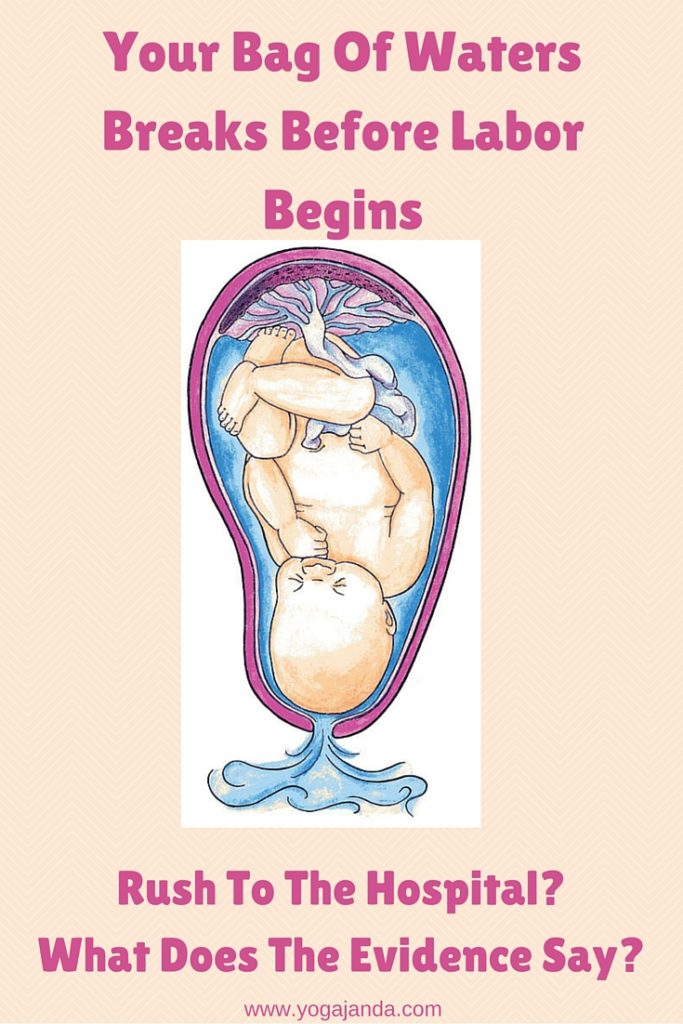 How and when did this issue of PROM (Premature Rupture Of Membranes) and risk of infection become an urgent problem? It used to be that if you were part of the 10-12% of women who were full term (37-42 weeks), and whose waters broke before labor began, you would just ignore it the best you could – NO BIG DEAL – baby is on the way! The best and safest option was to wait for labor to begin on its own. Most women – 85% – will naturally go into labor within 24-48 hours. Take steps way before your due date to avoid this problem altogether. Increase your chances of avoiding induction. Read: 6 Steps To Keep Your Amniotic Sac Healthy And Strong
How and when did this issue of PROM (Premature Rupture Of Membranes) and risk of infection become an urgent problem? It used to be that if you were part of the 10-12% of women who were full term (37-42 weeks), and whose waters broke before labor began, you would just ignore it the best you could – NO BIG DEAL – baby is on the way! The best and safest option was to wait for labor to begin on its own. Most women – 85% – will naturally go into labor within 24-48 hours. Take steps way before your due date to avoid this problem altogether. Increase your chances of avoiding induction. Read: 6 Steps To Keep Your Amniotic Sac Healthy And Strong
The primary cause of infection in a woman whose bag of waters has broken is a cervical check. Gravity is causing all fluids to move in a downward direction. But when a nurse, doctor, or midwife does a cervical check, she/he is actually forcing bacteria from the birth canal back up through the cervix into the uterus. This is how the bacteria are first introduced. The bacteria outside and inside the birth canal can be harmful to the amniotic sac, amniotic fluid, and placenta. If an infection develops, it is called Chorioamnionitis. By pushing bacteria from the birth canal into the uterus, you put you and your baby at risk for infection. Of course, when you arrive at your hospital this is one of the first of many procedures that will be done to you.
Worst-Case Scenario – The Reason For The “Emergency”
Liability, insurance companies, and hospitals – businesses – are running the show now. The decision to start labor immediately is not necessarily based on medical evidence. Care providers and hospitals have to give you the worst-case scenario so that they won’t be sued later if you do get an infection. Unless there is clear medical evidence that your health and your baby’s health and safety are in jeopardy, there is no reason to hasten the start of labor. Trusting in and having patience for the process of labor is a real challenge, when everyone around you is telling you you’re putting your baby’s safety at risk. But forcing something, in this case labor to start, is a form of violence and rarely works out well. 40-60% of inductions fail. That means that those inductions end in an unplanned Cesarean and many of those babies end up in the Neonatal Intensive Care Unit.
Labor Needs To Begin In A Calm, Peaceful Environment
Can you picture yourself calm and relaxed in the car on the way to the hospital? I’m guessing, No. Picture the hospital. Is being in an unfamiliar, sterile environment, surrounded by strangers coming in and out of your room a place where you can feel relaxed and comfortable? Hmmm – probably not. If you’re not relaxed and comfortable, labor will not begin. Or it will begin in fits and starts or very slowly. Then you will need to speed things up with Pitocin.
These are the words you should use to describe the best environment to be in where labor can begin:
- Calm
- Placid
- Serene
- Tranquil
- Low-pressure
You’re not going to find that in a hospital!
What Can You Do When Your Water Breaks Before Labor Begins?
Your Options are
I like to use the acronym T.A.C.O.:
- Time – note the time your water broke
- Amount – note the amount of water. Did you experience a pop and a gush? Or is it a slow trickle? You’ll need a pad. Do not use a tampon!
- Color – it should be clear. If it is not clear and is greenish, cloudy, call your care provider.
- Odor – It should not have any smell. If it smells like urine, you peed in your pants. If it has a strong odor other than urine, call your care provider.
- Plan ahead and increase your chances of a natural onset of labor
- Wait for labor to begin on its own
- Try to naturally induce labor (see #’s 10-14, below).
- Take your temperature every hour to monitor that you don’t develop an infection.
- Eat!
- Drink water with electrolytes or my Labor-Aid.
- Take a walk.
- Take a nap.
- Take a shower.
- Cuddle with your honey but do not put anything in the vagina.
- Avoid vaginal exams/cervical checks.
- Do the Miles Circuit www.milescircuit.com
- Get Acupuncture http://www.aaaomonline.org/search/custom.asp?id=320
- Try acupressure – http://www.healthline.com/health/pregnancy/acupressure-points-inducing-labor
- Do nipple stimulation for several hours – http://www.bellybelly.com.au/birth/nipple-stimulation-how-to-do-nipple-stimulation-for-labour /
- Take the homeopathic remedy Caulophyllum and/or Cimicifuga in a 30C
- If choosing induction, choose Pitocin drip over a cervical ripening agent.
Medical Research Suggests: It’s safe to wait to induce For 18 Hours
The Cochrane study says, “While the original trial report found no difference in neonatal infection rates between immediate induction and expectant management overall, the secondary analyses make clear that length of time between rupture and delivery matters.” If you are GBS positive the study said that awaiting the onset of labor is acceptable as long as the antibiotics are initiated.
Not only does experience show that waiting for labor to begin is the best option for most women, but medical research suggests waiting 18 hours before interfering and inducing labor. Talk to your birth partner about what you’d like to do if PROM happens to you. Then discuss it with your care provider. Ask them if they can provide you with research that backs up the need to induce labor. Remember that the final decisions are yours to make, and yours to live with.
Read more about the research in this article by Henci Goer (below) an acknowledged expert on evidence-based maternity care, author, and speaker.
| When Research is Flawed: Should Labor Be Induced Immediately with Term Prelabor Rupture of Membranes? |
by Henci Goer
Commentary on: Hannah, M. E., Ohlsson, A., Farine, D., Hewson, S. A., Hodnett, E. D., Myhr, T. L., et al. (1996). Induction of labor compared with expectant management for prelabor rupture of the membranes at term. TermPROM study group. N Engl J Med, 334(16), 1005-1010. [Abstract]
Study design and results: multicenter, multinational randomized controlled trial in developed countries of 5041 women with confirmed PROM at ≥ 37 completed weeks of gestation. Women were not in active labor, had a singleton fetus in cephalic presentation, and had no contraindication to trial participation.
Investigators randomly allocated trial participants to one of four groups: (1) immediate induction with oxytocin, (2) expectant management for 4 days before oxytocin induction or until an indication for induction developed, (3) immediate induction with prostaglandin E2 (PGE2) followed by oxytocin if necessary, or (4) expectant management for 4 days before PGE2 induction or until an indication for induction developed.
- Selected background information [Note: These represent ranges in rates reported among the 4 study groups. No significant differences across groups were detected for any of the following:]
- vaginal exam at trial admission: 35-39% digital, 64-67% speculum
- number of digital vaginal exams: 49-63% had ≥ 4
- Group B strep (GBS) status: 9-12% tested positive for GBS
- median time to active labor in expectant groups: 16-17 h
- Selected maternal outcomes:
- cesarean rate: rates ranged among the 4 groups from 10-11% overall, 14-15% nulliparous women, 4-5% multiparous women
- any sign of chorioamnionitis:
- 0% induction/oxytocin vs. 8.6 % expectant/oxytocin, p < 0.001 [Absolute difference: 4.6%. Absolute difference for diagnosis based on criteria other than intrapartum fever (fever before labor, elevated white blood cell count, or foul-smelling amniotic fluid): 2.3%.]
- 2% induction/prostaglandin vs. 7.8% expectant/prostaglandin. Difference did not achieve statistical significance, meaning it was likely to be due to chance.
- Neonatal outcomes:
- neonatal infection: rates ranged from 2-3% and were not significantly different across the 4 groups
- stay in neonatal intensive care unit > 24 h:
- 7% induction/oxytocin vs. 12% expectant/oxytocin, p < 0.001.
- 9% induction/prostaglandin vs. 10% expectant/prostaglandin. Difference did not achieve statistical significance
- antibiotics:
- 8% induction/oxytocin vs. 14% expectant/oxytocin, p < 0.001.
- 11% induction/prostaglandin vs. 12% expectant/prostaglandin, p = 0.003.
- All other neonatal outcomes were similar, including, fetal distress, meconium-stained amniotic fluid, Apgar score < 7 at 1 or 5 min, cord blood pH < 7.1, need for oxygen resuscitation, jitteriness or irritability, seizures, hypotonia, abnormal level of consciousness, apnea, abnormal feeding at 48 h or more, and ventilation after resuscitation.
Problems include but are not limited to the following:
- Failure to consider the effect of epidural analgesia on intrapartum fever confounds chorioamnionitis results. Most diagnoses of chorioamnionitis were made on the basis of intrapartum fever. At the time of the trial, the association between epidural analgesia and intrapartum fever was not widely known, and no adjustment was made for this factor. Had this been done, an excess probably would remain in the expectant group, but infection rates might have been lower in all groups.
- Women who were colonized with GBS were not treated in labor. A secondary analysis looked at the effect of GBS status, based on vaginal swabs obtained at trial entry, on outcomes (Hannah, 1997). Calculations using that study’s data reveal that one-third of neonatal infections were in women testing positive for GBS. GBS also caused one of the four deaths in the expectant group in babies without lethal anomalies. Current standard practice—screening for GBS at the end of pregnancy and providing antibiotics in labor to those who are colonized—would have reduced, and might have eliminated neonatal infections in GBS + women, thus reducing infection rates overall, and it might have prevented the death. It is also possible that GBS status would not have been a factor or would have been less of a factor in neonatal infections were it not for women having vaginal exams at trial entry and multiple exams before delivery. (See next bullet points.)
- Chorioamnionitis rates and possibly neonatal infection rates were confounded by multiple digital vaginal exams. Leaving aside epidural analgesia as a confounding factor in diagnosing chorioamnionitis, yet another secondary analysis reported that chorioamnionitis increased steadily with number of digital vaginal exams independent of other factors (Seaward, 1997). Compared with less than three, the odds ratio climbed from a 2-fold increase for 3 to 4 exams to a 5-fold increase with more than 8. Seaward (1998) reported in their evaluation of risk factors for neonatal infection that chorioamnionitis had the strongest independent association. The rate among infants of women with chorioamnionitis was 16%, a six-fold increase over those not experiencing chorioamnionitis.
- Neonatal infection rates were confounded by vaginal exams at trial entry. A secondary analysis of trial data found that having a vaginal exam at trial entry increased the risk of neonatal infection by 250%, even after taking into account GBS status (Hannah, 1997). This difference is likely to be greater than appears because the analysis authors chose to combine digital and speculum exams, although only digital exams are believed to increase the risk of infection.
- Neonatal infection rates were confounded by multiple digital vaginal exams during labor. According to another secondary analysis, the percentage of infections trended upward with the number of vaginal exams independent of other factors, including time from rupture of membranes to labor onset and length of active labor (Seaward, 1998). It rose from 2% in women with 3 to 4 exams to 5% in women with more than 8. The odds roughly doubled compared with women having fewer than 3 vaginal exams, although the difference only achieved statistical significance when 7 to 8 exams were compared with fewer than 3.
Comment: Based solely on the TermPROM trial, the American College of Obstetricians and Gynecologists (ACOG) recommends immediate induction, generally with oxytocin, for women with term PROM on the grounds that inducing labor will reduce chorioamnionitis, febrile morbidity, and neonatal antibiotic treatments without increasing cesarean rates (ACOG, 2007). The primary argument for immediate induction has always been reducing neonatal infections, which ACOG acknowledges it does not do, and, as can be seen in this deconstruction, with optimal care other benefits are likely to be smaller than currently appear.
By contrast, a Cochrane systematic review published in 2006 also evaluates term PROM management (Dare, 2006). Despite being heavily dependent on the TermPROM trial—three-quarters of the 6800 participants among the 12 trials in total come from the TermPROM trial—the reviewers reach a more tempered conclusion: “Since differences in outcomes between planned and expectant management may not be substantial, women need to be able to access the appropriate information to make an informed choice (p. 12).”
In summary, in the absence of signs of infection, expectant management remains a viable option. Nonetheless, the secondary analyses have given us a more nuanced picture. While the original trial report found no difference in neonatal infection rates between immediate induction and expectant management overall, the secondary analyses make clear that length of time between rupture and delivery matters. They also found that modifiable factors affected infection rates, which means we do not know what they would have been with optimal care.
For those choosing expectant management, the question arises of how long to wait before inducing labor if one prefers to set a limit. Consider the following: Seaward (1998) reported that time from membrane rupture to labor onset of 24-48 hours versus less than 12 hours was an independent predictor of neonatal infection. Infection rates with 24 hours or more to onset of labor were 4% versus the background 2% rate. Hannah (1996) reported that the median time to active labor, not labor onset, after membrane rupture was 16-17 hours. It therefore seems reasonable to wait about 18 hours before inducing labor. Half the group of women will have achieved active labor by this time, and, if induced, the remaining half are likely to have started labor by the 24-hour cut point.
Women with PROM at term who are GBS + constitute a special subset. The Centers for Disease Control (2002) guidelines for management of GBS + women say nothing about inducing women with ruptured membranes at term, which suggests that awaiting spontaneous labor is acceptable provided that antibiotic therapy is initiated. And given that it takes time to instill the recommended dose of antibiotics, common sense dictates that women who prefer not to wait for labor should delay induction until they have an adequate dose of antibiotics on board.
In any case, regardless of GBS status or decisions around whether or when to induce, to minimize the risk of infection, women should avoid digital vaginal exams until established in labor, and their use should be minimized during labor. Data also suggest that oxytocin is the induction agent of choice. It appears to reduce infection rates compared with PGE2 without any offsetting disadvantages.
References:
ACOG. (2007). Premature rupture of membranes. Practice Bulletin No. 80.
Centers for Disease Control and Prevention. (2002) Prevention of perinatal group B streptococcal disease. MMWR;51(No.RR-11).
Dare, M. R., Middleton, P., Crowther, C. A., Flenady, V. J., & Varatharaju, B. (2006). Planned early birth versus expectant management (waiting) for prelabour rupture of membranes at term (37 weeks or more). Cochrane Database Syst Rev(1), CD005302.
Hannah, M. E., Ohlsson, A., Farine, D., Hewson, S. A., Hodnett, E. D., Myhr, T. L., et al. (1996). Induction of labor compared with expectant management for prelabor rupture of the membranes at term. TermPROM study group. N Engl J Med, 334(16), 1005-1010.
Hannah, M. E., Ohlsson, A., Wang, E. E., Matlow, A., Foster, G. A., Willan, A. R., et al. (1997). Maternal colonization with group b streptococcus and prelabor rupture of membranes at term: The role of induction of labor. TermPROM study group. Am J Obstet Gynecol, 177(4), 780-785.
Seaward, P. G., Hannah, M. E., Myhr, T. L., Farine, D., Ohlsson, A., Wang, E. E., et al. (1997). International multicentre term prelabor rupture of membranes study: Evaluation of predictors of clinical chorioamnionitis and postpartum fever in patients with prelabor rupture of membranes at term. Am J Obstet Gynecol, 177(5), 1024-1029.
Seaward, P. G., Hannah, M. E., Myhr, T. L., Farine, D., Ohlsson, A., Wang, E. E., et al. (1998). International multicenter term prom study: Evaluation of predictors of neonatal infection in infants born to patients with premature rupture of membranes at term. Premature rupture of the membranes. Am J Obstet Gynecol, 179(3 Pt 1), 635-639.










